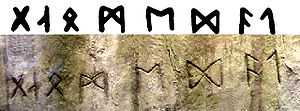Heavener Runestone
 Heavener runestone with the runes copied above. | |
| Name | Heavener Runestone |
| Country |
|
| Region | Poteau Mountain |
| City/Village | Heavener, Oklahoma |
Text - Native | |
| Elder Futhark | |
| Other resources | |
|
Runestones - Runic alphabet Runology - Runestone styles | |
The Heavener Runestone is an inscribed stone located in Heavener, Oklahoma. The land on which it sits is no longer a state park as of 2011 due to budgetary constraints. Heavener Runestone which was formerly known as Heavener Runestone State Park is on Poteau Mountain, just outside the town limits. The origin of the stone's runic carvings is disputed.[1]
Inscription
The inscription has been rejected by Scandinavian philologists and runologists, who consider it most likely modern (19th or early 20th century). The reading of the "Elder Futhark" style runes is probably "GNOMEDAL" (meaning "Gnome Valley", or perhaps a personal name "G. Nomedal").
The difficulty of using the Heavener Runestone to demonstrate Viking exploration of the area is that the Elder Futhark had become obsolete by the 8th century, long before the Viking expeditions to Greenland and Vinland. Also, only six of the eight characters are correct Elder Futhark runes. A transliteration would read "G [rough backwards N] O M E D A [backwards L]".
Archaeological research
Archaeologist Ken Feder notes that unlike the situation in eastern Canada where evidence has been found that proves a Norse presence, nothing similar has been found anywhere near Heavener or even in the American Midwest. He suggests that "it is unlikely that the Norse would get significantly more fastidious about leaving any evidence behind of their presence in Oklahoma."[2]
Archaeologist Lyle Tompsen in a 2007 Masters Thesis for the University of Leicester (later published in ESOP 29 2011:5-43) examined the rune stone and noted:
- There is no cultural evidence of Vikings in or near the region.
- No Old Norse approach to translation fits this stone.
- The stones most likely translation is 'Gnome Dal' (Valley of the Gnomes).
- Scandinavian presence in the nearby town of Heavener is early and the likeliest source of the carving of the stone.
- Other purported rune stones in the region are modern creations, or misinterpreted Native American rock art.
"Barring any new evidence, the stone is best considered a modern creation."[3]
Cultural significance
- In 1991, Carl Albert State College in nearby Poteau changed its mascot to a Viking in the stone's honor.
- Don Coldsmith's 1995 novel Runestone, offers a speculative theory about how an 11th-century Viking could have made his way to the area of Heavener.
See also
- Poteau Runestone, which bears the same inscription
- Shawnee Runestone
- Turkey Mountain inscriptions
- Kensington Runestone
References
- ↑ "North American Rune Stones". Sunnyway.com. Retrieved 2013-03-27.
- ↑ Kenneth L. Feder, Encyclopedia of Dubious Archaeology: From Atlantis To The Walam Olum, page 137 (Greenwood, 2010). ISBN 978-0-313-37919-2
- ↑ Tompsen, Lyle. "An Archaeologist Looks at the Oklahoma Runestones ESOP 29, 2011: 5-43 | Lyle Tompsen". Academia.edu. Retrieved 2013-03-27.
External links
- North American Rune Stones
- The Oklahoma Runestones
- The Heavener Runestone
- Heavener Runestone State Park
- Epigraphic Society Occasional Papers (ESOP) 29:2011
Coordinates: 34°53′55″N 94°34′45″W / 34.89861°N 94.57917°W